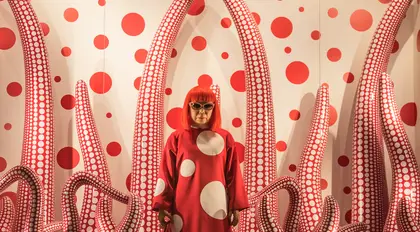On the terrace of Tokyo’s Yayoi Kusama Museum, a huge, brightly-colored flower greets visitors, offering a lovely nod to the artist’s favorite theme. This monumental sculpture, visible from the top floor of the museum, is in dialogue with the surrounding urban landscape and provides a colorful landmark in the neighborhood.
As part of the Echigo-Tsumari Contemporary Art Triennial in Niigata prefecture, Kusama’s installations were also presented outdoors, temporarily transforming the Japanese rural landscape into an open-air art gallery.
These outdoor works testify to Kusama’s ability to transcend traditional exhibition spaces to create total artistic experiences, where the boundaries between art and everyday life become blurred. Whether through her giant pumpkins, monumental flowers or immersive installations, the artist invites the public to physically enter her disturbing and enchanting mental universe.
Kirishima Open-Air Museum address: 220 Koba 6340, Yusui-cho, Aira-gun, Kagoshima, Kyūshū
Website: https: //open-air-museum.org/en/
Japanese contemporary art museums exhibiting Kusama’s work
In addition to the institutions already mentioned, many contemporary art museums across Japan present permanent collections or temporary exhibitions dedicated to Yayoi Kusama. These venues offer the opportunity to discover different facets of her prolific oeuvre.
The Fukuoka Art Museum, in southern Japan, boasts an extensive collection of Kusama’s work, mainly paintings, but also a number of sculptures and installations. The collection includes works that reflect the artist’s commitment to peace and universal love. Visitors can admire his famous “Infinity Net” series, canvases covered with small circles that create a sensation of infinite depth. For just 200 yen, this permanent collection offers a comprehensive overview of Kusama’s work and its importance in the contemporary art world.
Other major institutions regularly exhibiting works by Kusama include:
MOMAT (National Museum of Modern Art), TokyoKyoto National Museum of Modern ArtOsaka National Museum of ArtHara Museum of Contemporary Art, TokyoMOT (Museum of Contemporary Art), TokyoMori Art Museum, TokyoChiba City Museum of Fine ArtsHiroshima Museum of Contemporary Art
These museums present a variety of Kusama’s works, spanning her entire career, from her earliest figurative works to her most emblematic contemporary installations. They enable visitors to understand the evolution of her style and the recurring themes that run through her work: obsession, infinity, nature, repetition, self-obliteration and the spiritual quest.
The Pola Art Museum in Hakone also deserves a special mention for its “Bed, Dots Obsession” exhibition, which explores the evolution of the artist’s career in an exceptional natural setting. For 1,800 yen, visitors can admire Kusama’s characteristic polka-dot motifs in an immersive, dreamlike atmosphere.
Fukuoka Art Museum address: 1-6 Ohori Koen, Chuo-ku, Fukuoka city, Fukuoka prefecture, 810-0051 Japan
Website: https: //www.fukuoka-art-museum.jp/en/
Address of the Pola Art Museum in Hakone: 1285 Kozukayama, Sengokuhara, Hakone-machi Ashigarashimo-gun, Kanagawa Prefecture, 250-0631 Japan
Website : https://www.polamuseum.or.jp/en/
Practical tips for visiting the Kusama exhibitions in Japan
To make the most of your discovery of Yayoi Kusama’s works in Japan, here are a few practical tips to help you plan your artistic itinerary.
First of all, for the Yayoi Kusama Museum in Tokyo, reservations are imperative and must be made well in advance. Tickets go on sale on the first day of each month at 10 a.m. (Japanese time) for the following month. For example, tickets for May go on sale on March 1. Given the museum’s popularity, we strongly recommend that you book as soon as the ticket office opens. Please note that no tickets are sold on site, and only online reservations via the museum’s official website are possible.
For the Naoshima pumpkin tour, ideally plan a full day to explore the island. Ferries depart regularly from Takamatsu harbor, and the crossing takes about an hour. Check timetables in advance, especially if you want to make the round trip during the day. As the island is small, it can easily be explored on foot or by bicycle (available for hire).
The Matsumoto Art Museum is easily accessible from Tokyo (2h30 by train on the Chuo Line-Limited Express) or Nagoya (2h by train on the JR Shinano Express). It’s a 15-minute walk from Matsumoto station. Take advantage of your visit to discover the nearby Matsumoto Castle, one of the most beautiful in Japan.
For Infinity Rooms, please note that due to their popularity, the time spent inside is generally limited (often 2 minutes). So be prepared for an intense but brief experience, and be prepared to queue, especially in museums that don’t operate on reservation.
Finally, plan your itinerary according to geography. If you’re short on time, concentrate on Tokyo, which is home to several museums exhibiting Kusama’s work. For a more complete experience, consider a tour that includes Tokyo, Hakone (for the Pola museum), Matsumoto and Naoshima. This tour will enable you to discover different facets of the artist’s work, from paintings to monumental outdoor installations.
Bear in mind that photography is often restricted or prohibited in certain parts of the exhibitions, notably the Infinity Rooms. Find out in advance about each museum’s photo policy to avoid disappointment.


AloJapan.com